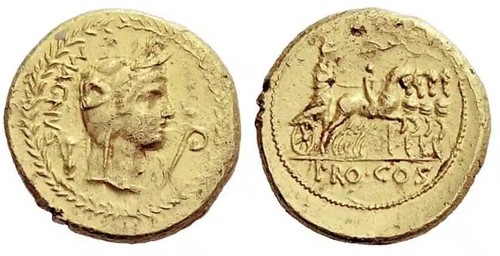
PREV ARTICLE
NEXT ARTICLE
FULL ISSUE
PREV FULL ISSUE
THE ANCIENT COINS OF POMPEY THE GREATMike Markowitz published a CoinWeek article on the Ancient Coins of Pompey the Great. Here's an excerpt - see the complete article online. -Editor
ROMAN ARISTOCRAT AND general Gnaeus Pompeius (better known to English speakers as Born September 29, 106 BCE in the Italian province of Picenum, he was the son of Pompeius Strabo, a rich landowner who became a Roman senator and eventually consul in 89 BCE. At the age of 16, young Pompey accompanied his father on campaign in the Social War.
In the bloody and protracted civil wars that wracked the dying decades of the Roman republic, young Pompey sided with the dictator Sulla, raising and training an army at his own expense. In recognition of Pompey's victories, Sulla awarded him the honorific title of Magnus ( The first coin attributed to Pompey is an extremely rare gold aureus, probably issued at Rome on the occasion of his triumph in 71 BCE, although some sources question this date (Kopij, 111). Only five examples of this coin are known, all but one in museums. The best-known published example is in the British Museum, purchased in 1867 from French collector Louis Duc de Blacas (1815-1868).
The aureus, valued at 25 silver denarii (a month's pay for a mercenary soldier) was not a regular part of the currency at this time; it was only issued on special occasions. On the obverse, the head of a female wearing an elephant headdress and surrounded by a laurel wreath represents Africa, where Pompey won some of his victories. The inscription is simply MAGNVS (
To read the complete article, see:
Wayne Homren, Editor The Numismatic Bibliomania Society is a non-profit organization promoting numismatic literature. See our web site at coinbooks.org. To submit items for publication in The E-Sylum, write to the Editor at this address: whomren@gmail.com To subscribe go to: https://my.binhost.com/lists/listinfo/esylum All Rights Reserved. NBS Home Page Contact the NBS webmaster 
|

